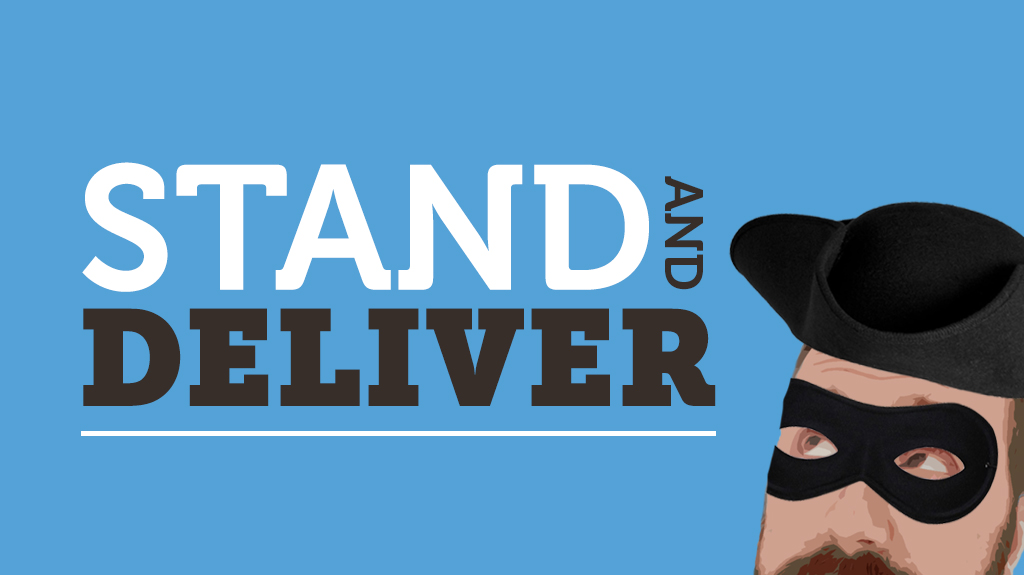Stand and Deliver – Presentations are Performance
Presentations can be dull. We’ve previously talked a lot about making sure you get the most from them, with a free downloadable PDF guide and our 7 top presentation tips video.
Today we’re honing-in on one key element to a successful presentation. If you forget all else, you should remember this – a presentation is a performance.
It’s time to stand and deliver.
As the presenter it’s worth considering your “performance”. If you think about high-profile presentations that you may have been impressed by (for example conference keynotes or tech product launches) in addition to a lot of practice, the presenters will most likely have had coaching on public speaking and performance.
Whether you’re presenting to a huge auditorium, being live streamed around the world to eager tech fans, or simply presenting to a handful of people in a meeting room, the fundamentals of performance remain the same.
So, here’s seven handy tips that you could consider next time you’re planning a presentation…
1. Practice, practice, practice
It’s a cliché but practice makes perfect. Some people may feel nervous (or self-conscious) practicing a presentation either by themselves or with a “fake” audience. But practice is the only way you can really gain confidence in what you’re planning to say and do before the real deal.
Live performers rehearse, and the same should be true for presenters. Taking the time to practice helps iron out anything that doesn’t quite land and means you can go into the “real” presentation with better direction.
2. It’s all about them
We’ve said it before, but remember that presentations are about your audience, not about you.
While it may not always be possible depending on the situation, if you can make your presentation a two-way street, a conversation, then you’ll get better buy in from your audience. You’ll demonstrate that you’re not just there to talk at them for half an hour (or more!), but rather wanting to understand them and how what you’re talking about relates to and can benefit them specifically.
In terms of how you actually present in this way, you could make sure you offer questions and make it clear that they’re not rhetorical – that you actually want a response!
3. Be present
This sounds pretty zen, but what we’re talking about here follows on from the point above and is about making sure you actually pay attention to how the audience is reacting.
While practice can help you make perfect, don’t let it make you into a robot. Take the time to breathe and gauge how the room is reacting to your message and delivery. You can adjust and tweak your presentation accordingly to keep them engaged.
4. Breathe
Talking of breathing, it’s a pretty important part of standing up straight, let alone talking to a room full of people. Don’t be afraid to leave a pause. They allow impactful points to really land with audiences and give you a chance to catch your breath.
When you’re first starting out presenting, there’s a good chance you may rush through for fear of leaving “dead air” or awkward silences. Own those moments and know that not only do you need them in order to remain upright, but your audience needs them to ensure they have time to properly digest your message.
Remind yourself that you are in control!
5. Body language
Holding yourself upright can help with vocal projection and in turn demonstrate confidence in the words you’re saying. That’s just one example of how body language and non-verbal communication can play a part in your presentation.
Consider what you’re doing with your hands, how you hold yourself and how you reference your AV content. For example, you want to make sure you present to the audience rather than to the screen that your PowerPoint file is displaying on… so make sure you’re actually facing your audience!
6. Be relatable
People will take more away from a presentation that they can relate to. In a sales presentation for example, this could be by using case studies and client success stories that are relevant to the specific audience you’re presenting to. In other situations, it may be that a personal story that resonates with other people is enough to demonstrate a point.
Consider how you want your audience to actually feel while they’re seeing you present (and how they remember you afterward) as a starting point for these human anecdotes.
Making your audience feel something is the best way to tell a powerful story.
To be relatable, you need to come across as human (see above re: being present – no robotics!). So think about the delivery of these anecdotes, both in terms of the salient facts that will help you reach your relatable point, and also when best to use them within the context of the rest of your presentation to have the most impact.
7. End strong
A good strong ending is important in all forms of storytelling and means that people will be talking about your presentation long after you’ve left the room.Again, using a sales presentation as an example, being memorable can be the difference between you or the next competitor through the door “getting the gig”.
A strong ending will make sure that you’re not forgotten.
There you have it – seven tips for would-be presentation performers. And in an effort to end strong, here’s a mic drop…






Anthony Constantinou CEO CWM FX
Everything depends on the mindset if you start your presentation with positive mindset and confidence, no one can stop you to succeed. So be positive.